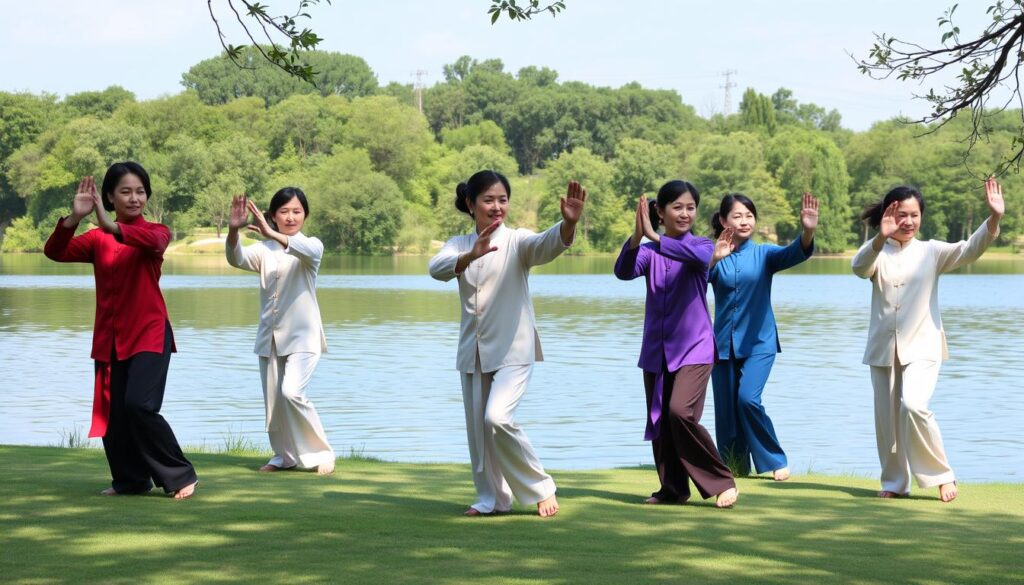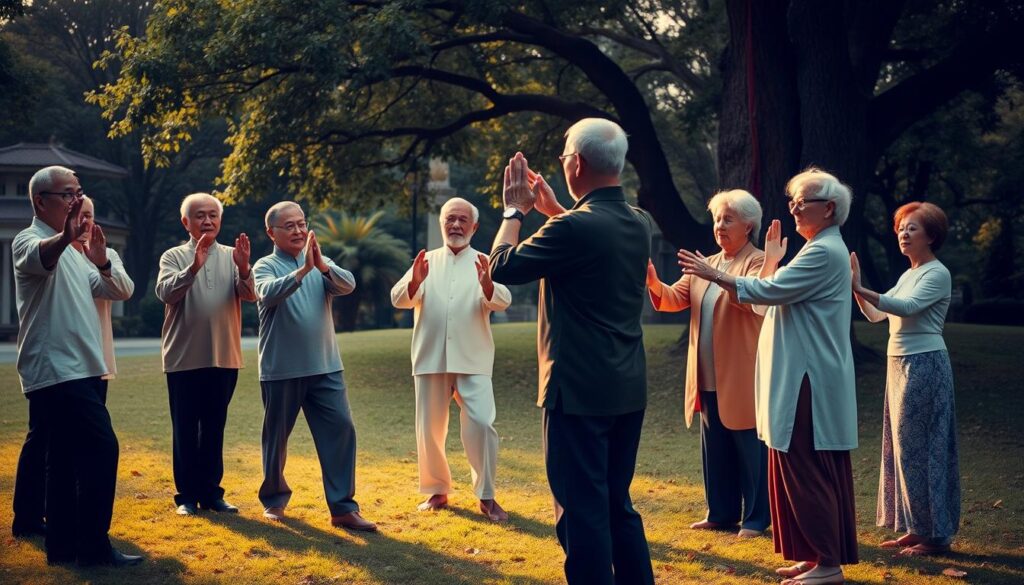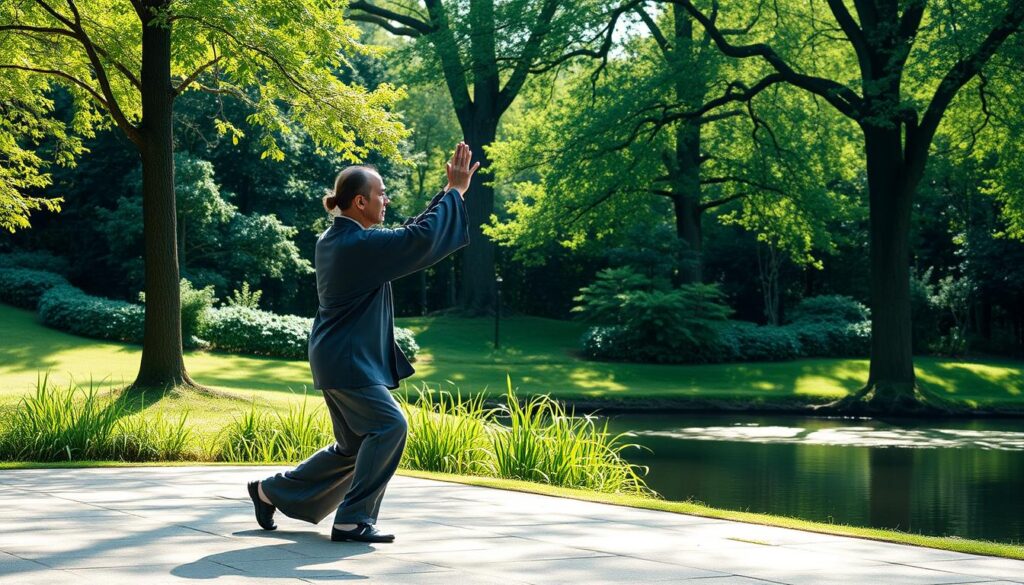It is very difficult to illustrate how to do Tai Chi in a book. It is a practice that is best learned through live instruction or video. It takes practice to really master its intricate details and principles and to properly integrate its three main components of movement, meditation, and breath.
Basic Guideliness
Here are some general guidelines when learning Tai Chi.
1. Warm up: As with any exercise, it is important to do a proper warm up. The warm up prepares the body for movement but it also prepares the mind, which is of special importance when doing Tai Chi because the intent of the mind leads the movements of the body. The main warm up exercises for Tai Chi include:
Shaking Arms
Shaking Body
Swing Arms from Side to Side
2. Training the mind: Training the mind is of the main elements of Tai Chi Chuan. The first posture is intended to prepare the mind for physical movement. Before the actual routine begins, the mind should be calm and steady, thoughts focusing inward and eyes looking forward. The goal is a complete state of calm and relaxation, brought on by releasing all tension, stress, and worries from the body and mind.
3. Fluid movement: The main Tai Chi routine movements should be performed slowly, and without stopping. The movements flow from one into the next in sequence as they are perfectly choreographed to do so. Imagine water flowing through a river, it never stops, or jerks. It maintains its speed and flows continuously.
2. Move against resistance: In order to reach your inner force or qi, it helps to imagine that you are moving against resistance, like pushing through water with your hands in a swimming pool.
3. Weight transference: Weight transference through each move should be carefully monitored in order to improve coordination and mobility. Remain aware of each step as you transfer your weight from one move into the other.
4. Form and posture: Remain conscious of your posture so that it remains correct and in a straight line as you move your feet one pose to the next. It is very important to maintain proper body alignment through every move. Maintain a straight line through the bending movements and learn not to curve the back. This is a skill that takes practice, as in everyday life people rarely maintain a proper posture through their activities, like the typical curving of the back when bending down to pick up something from the floor. In Tai Chi, this is of utmost importance, as form is critical for best results.
5. Silence: Avoid distractions and focus on each movement and allow your joints to naturally stretch from one move to the other.
The Meditation Element
The first thing to understand is that the practice of Tai Chi itself is a form of meditation. Through gentle, slow movements, and an inward focus you meditate as you move, technique is critical to reach an optimal meditative state.
Center yourself by breathing properly. Stand with your feet shoulder-width apart and put your hand on your abdomen just below your naval. Breathe solely through your nose, slowly, from your abdomen. If you cannot feel your abdomen moving, press in slowly with your hand until you do.
Relax and concentrate on all body parts simultaneously. Once your breathing feels normal, concentrate on relaxing your feet, ankles, calves, all the way up to the top of your head. This lets go of all tension, including the tension that you did not even realize was there.
Plant your root. Rooting yourself is a standard technique of Tai Chi. Imagine roots growing from the soles of your feet so that you become part of the ground. Your legs do not become stiff; in fact, your limbs may sway. This technique helps you to stay balanced and centered.
Begin forming positions. In general, contemporary Tai Chi styles either use small frame or large frame movements. Choose positions that interest you by browsing various styles and positions online (many websites offer pictures) or by experiencing them with an instructor.
Once you become familiar with Tai Chi, you will begin forming sets of movements according to your preferred style (or chosen instructor). As you transition from one position to another and fully engage in Tai Chi, remember to keep yourself centered, relaxed, and rooted.
This will enable you to fully embrace the meditative aspect of Tai Chi and you will learn to align your mind, body, and spirit. In doing so, you will enjoy all of the mental and spiritual benefits of Tai Chi, including building a strong mind. This will help you to prevent mental illnesses as well as combat any existing mental issues.
The Breathing Element
Breathing is an integral part of Tai Chi. The purpose of it is to store and deliver energy, which correlates with Tai Chi’s deliberate focus on internal energy.
The movements that you engage in through Tai Chi will prompt you to draw in, store, and deliver energy in an alternating fashion. Many refer to this as “opening and closing.”
When your body opens, it pulls in energy, storing it. When it closes, the energy releases. Think of it like drawing in an arrow and then shooting it.
Differences in Breathing Techniques
Tai Chi instructors differ in their beliefs of how to integrate breathing into the practice. Some think that the breathing should be deliberate and specific. For example, in each segment of a particular movement, you would breathe either in or out, quickly or slowly. You use the same breathing patterns each time you perform that specific movement.
Other instructors believe that this method is too restricting. They think that this causes you to place too much attention on breathing to the point that you are distracted from other important components and cannot easily improve in your overall form.
However, it is important to note that everyone responds differently. Some people have weaker lung capacity or prefer different speeds to their movements, which would make breathing patterns challenging. Practice different breathing techniques to determine what suits you, and aim to incorporate those into your Tai Chi sessions. You can find a variety of breathing styles and exercises online, in both video and word formats.
How To Improve Your Breathing Technique
As you inhale, imagine yourself drawing in qi, or life energy (oxygen). This is the energy you store in your body. As you exhale, you are delivering energy into your movement.
The movements of Tai Chi alternate between opening and closing, which mimics the way in which you are to breathe and control the flow of energy.
As your hands separate and pull apart, this is an opening movement. In Sun-style Tai Chi, one particular opening and closing movement is when you place your hands at the front of your chest. You open them and breathe in, drawing in and storing qi. As you turn your hands back together, you breathe out, delivering the energy.
In Yang-style Tai Chi, the Single Whip movement works a little differently. Towards the end of the Single Whip movement, as you open your hands outward, this is a closing movement, where you are delivering qi. Alternatively, the up and down movements of Tai Chi are relatively straightforward – when you move your arms up, you are breathing in and storing qi, and when you move them down, you are breathing out and delivering qi. This also applies to standing up and bending down.
These breathing techniques work in coordination with the physical motions and meditative exercises. The three components of Tai Chi – movement, meditation, and deep breathing – work simultaneously and enhance one another.
As you learn to perfect these three components, you will be able to control the flow of qi to align your mind, body, and spirit. If you are ever in doubt about when to breathe or how to breathe, relax and let go of the control over your breathing.
Do not force your breath and especially do not hold your breath, as this will disturb the flow of your energy. Through natural breathing, your breath will likely correct itself in tandem with your movements.
You can always consult your instructor when in doubt. Remember, practice makes perfect. Set up a regular routine for Tai Chi, and you will be on your way to a healthier mind, body, and spirit.



